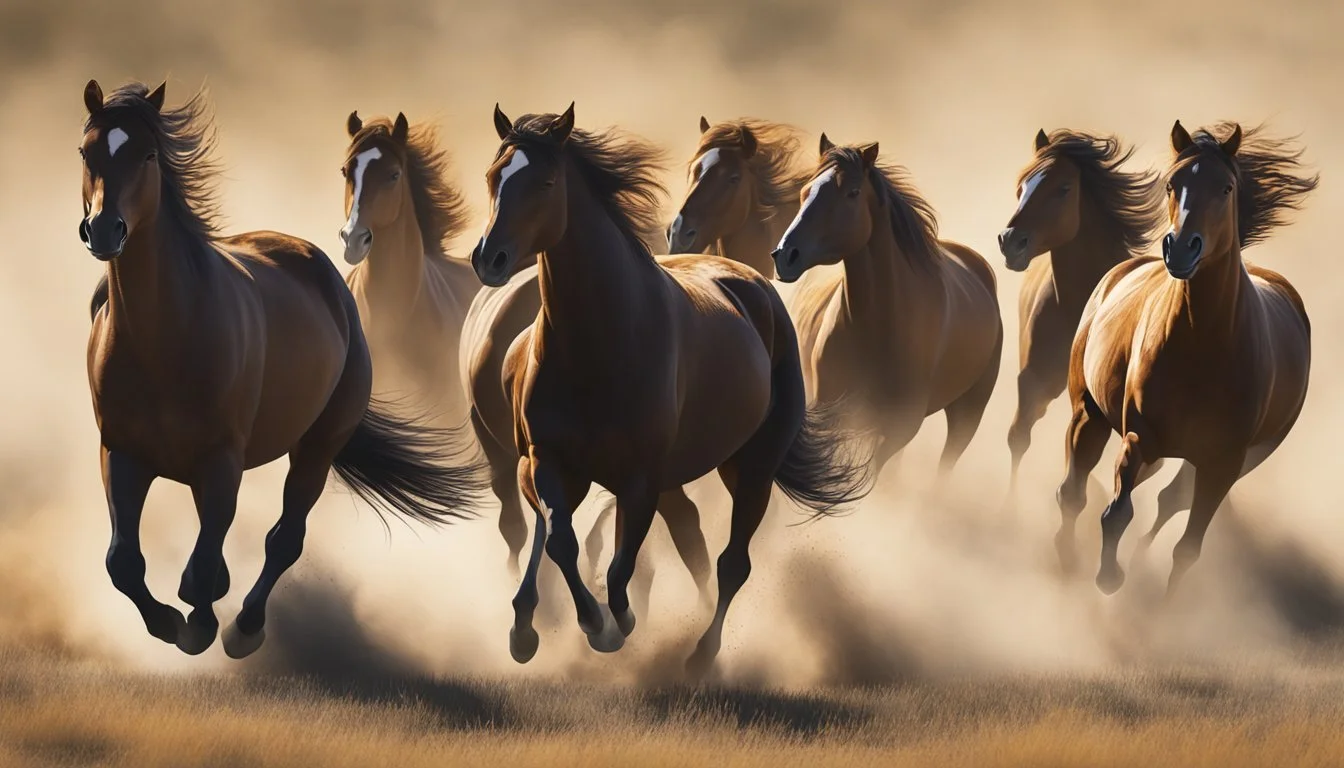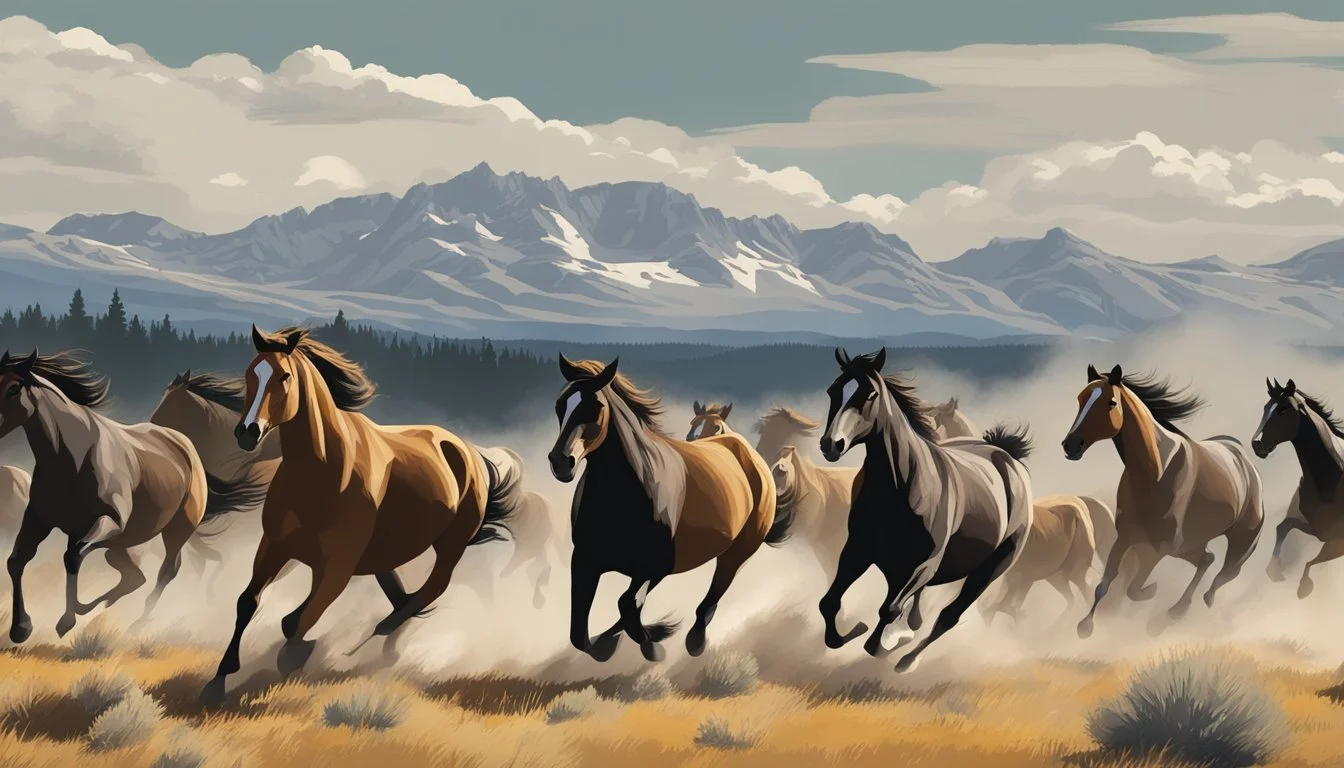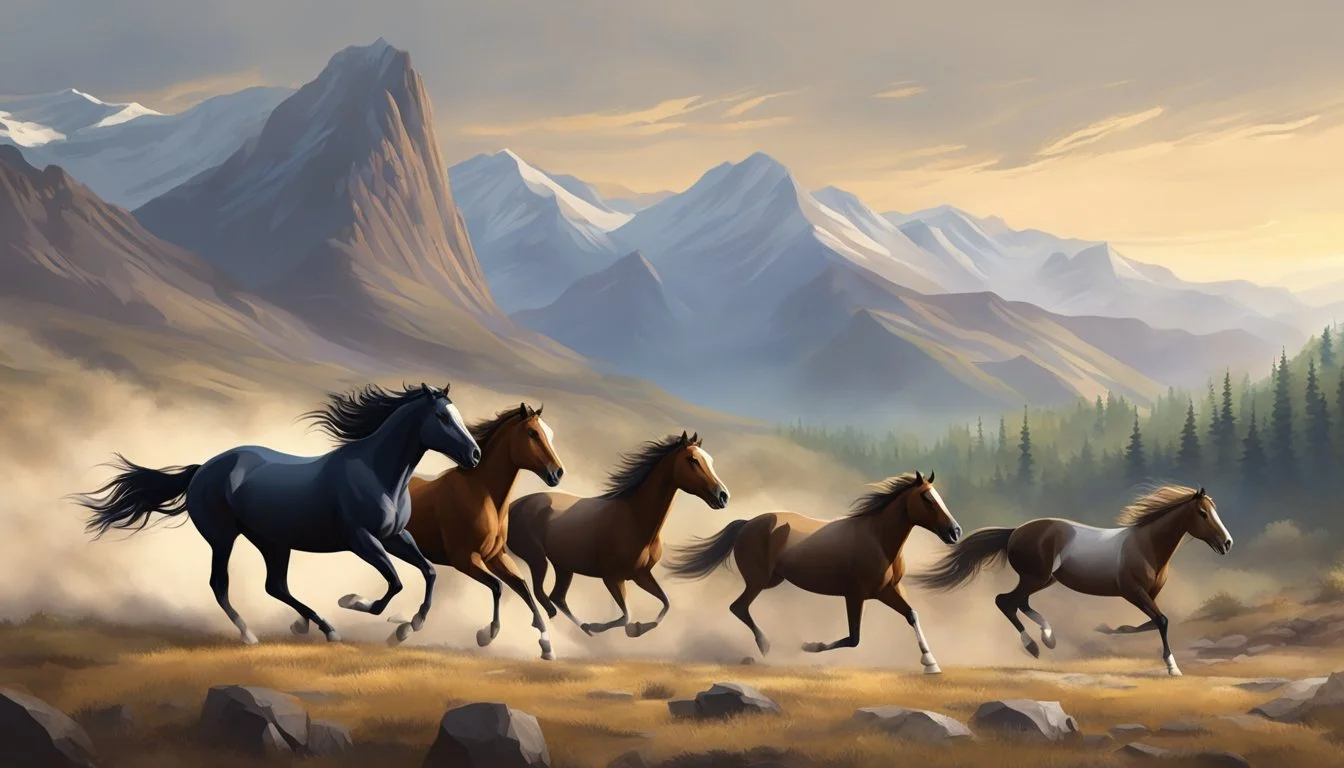The Significance of Horses in Yellowstone's Narrative
Shaping the Park's History and Ecosystem
Horses play a central role in the hit TV series Yellowstone, serving as both powerful symbols and essential elements of the show's rugged Western setting. Created by Taylor Sheridan and starring Kevin Costner as ranch owner John Dutton, the series showcases the deep connection between humans and horses in the American West. These majestic animals are not merely background props but integral characters that drive the narrative and reflect the personalities of their riders.
The show's creators have gone to great lengths to ensure authenticity in their portrayal of horses and horsemanship. Taylor Sheridan, an experienced horseman himself, provides many of the horses used in filming. This attention to detail adds a layer of realism that resonates with viewers and horse enthusiasts alike. From cutting horses demonstrating their skills to trusty mounts carrying characters through treacherous terrain, the equine cast members contribute significantly to the series' atmosphere and plot development.
Yellowstone's use of horses extends beyond practical transportation and ranch work. These animals often serve as metaphors for freedom, power, and the untamed spirit of the West. The way characters interact with their horses reveals much about their personalities and motivations, providing subtle insights into the complex dynamics at play in the Dutton family saga.
Origins and Cultural Relevance
Horses have played a pivotal role in shaping Yellowstone's identity and cultural landscape. Their presence intertwines with the region's ranching heritage and its portrayal in popular media.
Historical Context of Ranching
Ranching emerged as a significant economic activity in the Yellowstone area in the late 19th century. By 1923, numerous ranches dotted the Montana landscape surrounding the park. These ranches relied heavily on horses for daily operations, from herding cattle to transportation.
The Dutton family, fictional characters inspired by real ranching dynasties, exemplify the deep connection between horses and ranch life. Horses became symbols of freedom, power, and the untamed spirit of the West.
Ranchers developed a unique horsemanship style, blending practicality with showmanship. This expertise influenced the development of rodeos and other equestrian events that celebrated cowboy culture.
Yellowstone and Western Genre Revival
Yellowstone National Park has become a backdrop for reviving interest in the Western genre. The park's stunning vistas and wild horses capture the imagination of visitors and filmmakers alike.
Television series and films set in or inspired by Yellowstone often feature horseback riding prominently. These depictions reinforce the association between horses and the rugged beauty of the region.
The resurgence of Western-themed entertainment has sparked renewed interest in horseback riding and ranch experiences among tourists. Many visitors seek authentic encounters with horses to connect with the romanticized notion of the Old West.
This cultural phenomenon has contributed to the preservation of traditional horsemanship skills and the economic viability of horse-related businesses in the Yellowstone area.
Yellowstone's Cast and Characters
Yellowstone's characters form the heart of the show's gripping narrative. The Dutton family and their associates bring depth and complexity to the series, with each character contributing uniquely to the story's development.
John Dutton's Leadership
John Dutton, portrayed by Kevin Costner, stands as the patriarchal figure and ranch owner. His leadership style blends ruthlessness with a deep-seated love for his land and legacy. Costner's performance brings gravitas to the role, showcasing John's struggle to maintain control over his vast empire.
John's interactions with his children and adversaries alike reveal his complex nature. He often clashes with Thomas Rainwater, the nearby Native American casino owner, in a battle for land and resources.
John's horsemanship skills are evident throughout the series, with Costner performing many of his own riding scenes. This authenticity adds to the character's credibility as a seasoned rancher.
Beth Dutton's Complexity
Beth Dutton, John's daughter, is a force to be reckoned with in the Yellowstone universe. Her sharp wit and business acumen make her a formidable ally to her father and a feared opponent to his enemies.
Beth's character development throughout the series is marked by her fierce loyalty to family and her struggles with personal demons. Her relationship with Rip Wheeler adds layers to her persona, revealing vulnerability beneath her tough exterior.
Taylor Sheridan's writing brings Beth to life with cutting dialogue and intense scenes that showcase her multifaceted personality. Beth's role often involves strategic maneuvering rather than horseback riding, but her impact on the ranch's future is undeniable.
Rip's Role and Development
Rip Wheeler, the loyal ranch foreman, embodies the cowboy spirit central to Yellowstone's themes. His unwavering dedication to John Dutton and the ranch forms a cornerstone of the show's narrative.
Rip's character arc involves his deepening relationship with Beth and his role as John's right-hand man. His horsemanship skills are frequently on display, with the actor performing many of his own riding scenes.
Rip's presence on the ranch provides stability and enforces John's will. His interactions with other ranch hands and enemies of the Duttons showcase his complex nature - capable of both violence and compassion.
Horse Symbolism and Significance
Horses hold a special place in Yellowstone's cultural heritage, embodying the spirit of the American West. These majestic animals represent freedom, strength, and the enduring bond between humans and nature.
Representation of Cowboy Skills
Quarter Horses play a crucial role in showcasing cowboy skills within Yellowstone. These versatile equines excel in cutting, a discipline that highlights the partnership between horse and rider. The National Cutting Horse Association (NCHA) promotes this skill, which originated from ranch work separating cattle.
Cutting horses like Metallic Cat demonstrate incredible agility and cow sense. Their ability to anticipate and mirror a cow's movements reflects the intelligence and athleticism prized in working ranch horses. This skill set remains vital for modern ranching operations and preserves traditional cowboy techniques.
Rodeo and Competitive Scenes
Rodeo events in Yellowstone celebrate the region's horse culture and cowboy heritage. These competitions showcase the strength, speed, and precision of both horses and riders. Barrel racing highlights the agility of Quarter Horses as they navigate tight turns at high speeds.
Bull riding and bronc riding test the courage and skill of cowboys, while team roping demonstrates the coordination between riders and their mounts. These events not only entertain but also preserve essential ranching skills. Rodeos serve as a link between Yellowstone's past and present, honoring the horsemanship that shaped the American West.
Montana's Landscape and Set Design
Montana's rugged terrain and sweeping vistas serve as a stunning backdrop for Yellowstone's narrative. The show's creators meticulously craft an authentic representation of the state's ranching culture through careful location selection and set design.
Filming Locations and Authenticity
Yellowstone utilizes real Montana locations to capture the state's natural beauty. The production team scouts picturesque areas that showcase the diverse landscape, from rolling prairies to majestic mountains. Key scenes are filmed on actual working ranches to ensure authenticity.
Visual effects are employed sparingly to enhance the environment without compromising realism. The crew pays close attention to weather patterns and seasonal changes, incorporating them into the shooting schedule to maintain consistency.
Historical accuracy is prioritized in depicting Montana's ranching heritage. Period-appropriate buildings, equipment, and livestock are featured to create a convincing representation of the region's past and present.
Dutton Ranch as a Central Element
The Dutton Ranch serves as the heart of Yellowstone's storyline. Set designers recreate a traditional Montana cattle ranch with painstaking detail. The main house, barns, and outbuildings are constructed to reflect the architectural styles common in the area.
Interior spaces are furnished with a mix of antique and modern pieces, mirroring the blend of tradition and contemporary life in Montana ranching. Props and set dressing are carefully chosen to reflect the Dutton family's long history and current operations.
The ranch's layout incorporates key elements of a working cattle operation, including corrals, pastures, and riding areas. This attention to detail helps actors portray their roles convincingly and immerses viewers in the world of Montana ranching.
The Duttons and Native American Relations
The Dutton family's interactions with Native American characters in Yellowstone highlight complex historical and cultural dynamics. These relationships explore themes of land ownership, cultural preservation, and competing interests in the modern American West.
Cultural Representation and Critique
Yellowstone portrays Native American issues through several key characters and storylines. The show depicts conflicts over land rights, resource management, and cultural heritage between the Duttons and local tribes. While the series brings attention to real challenges faced by Native communities, it sometimes simplifies complex historical realities for dramatic effect.
The character of Monica Dutton, a Native American woman married into the Dutton family, serves as a bridge between cultures. Her story explores themes of identity and belonging in a mixed-heritage family. The show also features Native American actors in prominent roles, bringing authenticity to the portrayal of tribal customs and traditions.
Thomas Rainwater's Ambitions
Thomas Rainwater, the chairman of the Broken Rock Reservation, emerges as a formidable rival to the Duttons. His character embodies the struggle for tribal sovereignty and economic development. Rainwater's efforts to reclaim ancestral lands and build a casino resort create tension with the Duttons' ranching interests.
The show depicts Rainwater as a shrewd businessman and political strategist. His methods often mirror those of his opponents, blurring moral lines. This portrayal challenges stereotypes and presents a nuanced view of modern Native American leadership. Rainwater's character arc explores the complexities of balancing tribal traditions with contemporary economic realities.
Notable Horses of Yellowstone
Horses play a crucial role in Yellowstone's storytelling, with several equine stars gaining recognition. These remarkable animals contribute to the show's authenticity and appeal, showcasing both their individual personalities and impressive lineages.
Horses as Characters
Yellowstone's equine cast members are more than just props. They bring depth and realism to the ranch setting. Walla Walla Starbuck, a red dun stallion, made a memorable appearance in Season 1, Episode 5. This talented horse is not only a TV star but also a champion on the reining circuit.
High-Class Trash is another reining champion featured in the series. These horses demonstrate their skills in various ranch activities, adding authenticity to the show's portrayal of ranch life.
Famous Horses and their Lineage
The show features several horses with impressive pedigrees. Dun It Chexinic and Spookernickerin are two such examples, known for their performance abilities and bloodlines.
Lil Joe Cash is another notable equine actor in Yellowstone. These horses often come from successful reining and cutting horse lineages, bringing their real-world accomplishments to the screen.
Custom Made Gun, while not explicitly mentioned in the search results, likely fits into this category of well-bred, high-performing horses selected for the show. The inclusion of these accomplished horses adds credibility to Yellowstone's depiction of ranch operations and competitive events.
Yellowstone's Influence on Equestrian Sports
Yellowstone has made a significant impact on equestrian sports, particularly in cutting and reining disciplines. The show's portrayal of authentic horsemanship has sparked renewed interest in Western riding techniques and training methods.
Impact on Cutting and Reining
Yellowstone's realistic depiction of cutting and reining has brought these sports to a wider audience. Cutting, a competition where horse and rider separate a cow from a herd, features prominently in the show's ranch scenes.
This exposure has led to increased participation in AQHA (American Quarter Horse Association) events. The NRHA (National Reining Horse Association) has also seen a surge in membership since Yellowstone's debut.
Reining, a discipline showcasing a horse's athleticism and responsiveness, is often featured in the series. The show's attention to detail in these scenes has inspired viewers to explore these sports firsthand.
Horse Training and Cowboy Camp
Yellowstone's emphasis on authentic horse training methods has influenced real-world practices. The show's "Cowboy Camp" concept, where actors learn horsemanship skills, has been adopted by some ranches and equestrian centers.
This approach focuses on developing a strong bond between horse and rider. It emphasizes natural horsemanship techniques, which prioritize understanding equine behavior and communication.
Many trainers now incorporate elements of Yellowstone's horse training philosophy into their programs. This includes ground work exercises and low-stress cattle handling methods showcased in the series.
The show's portrayal of working ranch horses has also sparked interest in versatility training. More riders now seek horses capable of performing multiple disciplines, mirroring the multi-talented mounts seen on Yellowstone.
Legacy and Expansion of the Yellowstone Universe
Yellowstone's impact extends far beyond its original series, reshaping the Western genre and spawning multiple spin-offs. This expansion has created a rich tapestry of interconnected stories that explore different eras of the American West.
Influence on Modern Westerns
Yellowstone has redefined contemporary Western dramas, blending traditional elements with modern themes. The show's gritty realism and complex characters have set a new standard for the genre. Its success on the Paramount Network has sparked renewed interest in Western-inspired content across television and streaming platforms.
The series' authentic portrayal of ranch life and the struggles of maintaining a family legacy resonates with viewers. It has also brought attention to real-world issues facing the American West, such as land disputes and conservation efforts.
Expanding the Story with Spin-Offs
Taylor Sheridan's vision for the Yellowstone universe has led to several spin-off series. These shows explore different time periods and branches of the Dutton family tree, enriching the overall narrative.
"1883" delves into the Dutton family's 19th-century origins, while "1923" focuses on an earlier generation during Prohibition and the Great Depression. The upcoming "6666" spin-off will center on the historic Four Sixes Ranch in Texas, further expanding the franchise's scope.
These spin-offs provide deeper context to the Yellowstone saga, offering viewers a comprehensive look at the evolution of the American West and the Dutton legacy across generations.
Critical Reception and Viewership
Yellowstone's portrayal of rural Montana life and power dynamics has captivated audiences while sparking critical discussions. The show's popularity has grown exponentially since its debut, with viewership numbers reflecting its cultural impact.
Audience Engagement with the Series
Yellowstone's audience has expanded rapidly since its premiere on Paramount Network. The show's depiction of the Dutton family's struggles to maintain control of their ranch resonates with viewers across the country. Fans eagerly anticipate each new episode, discussing plot developments and character arcs on social media platforms.
The series' authentic portrayal of ranch life, including its focus on horses and cattle operations, has drawn praise from rural audiences. Urban viewers also find themselves drawn into the complex web of relationships and power struggles depicted on screen.
Evolving Storylines across Seasons
Season 3 marked a turning point for Yellowstone, introducing new threats to the Dutton family's empire. The addition of the Four Sixes Ranch (6666) storyline in Season 4 expanded the show's scope beyond Montana's borders.
Critics have noted the series' ability to maintain tension while exploring themes of family loyalty, land rights, and political maneuvering. Some viewers have questioned the authenticity of certain plotlines, particularly those involving Native American characters.
The show's creators continue to adapt storylines to audience feedback and cultural shifts, ensuring Yellowstone remains relevant and engaging for its devoted fanbase.









